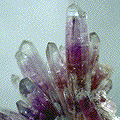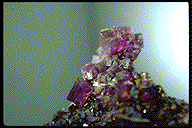The Evolution of Minerals
The Earth's Minerals have evolved over time, with perhaps two thirds of all minerals owing their existence to the effects of living organisms.
Robert Hazen (et al)1 describe the evolution of the various minerals from a few initial minerals to the thousands known today as conditions have changed over the Earth's history.
In the beginning of our solar system, only a few minerals existed, perhaps only about 60, all found today in the most primitive asteroids and comets.
A dozen of these have been identified in
Pre-solar grains
which condensed from solar nebulae (ours or the
outflows from other stars).
Minerals include several elements
(graphite,
diamond,
iron), and simple oxides
(magnetite,
corundum),
sulfides
(pyrite),
nitrides, and even carbides (silicon carbide, titanium carbide), phosphides (such as
CAIs
(Calcium-Aluminum-rich Inclusions) also predate the birth of our solar
system by perhaps 2 million years. These contain additional minerals,
including anorthite (CaAl2Si2O8),
Chondrules (millimeter-size
spherical grains characteristic of asteroids called
chondrites) likely condensed
from within our own solar nebula, and show evidence of flash heating to a liquid state
followed by rapid cooling. This supported the formation of additional minerals
(primarily silicates), raising the total to perhaps 60 minerals.
Type 1 chondrules appear to have formed under reducing conditions and are mostly
fosterite (Mg2SiO4) and
enstatite (MgSiO3)
with metallic iron or iron sulfides such as
Additional compounds undoubtedly existed, but conditions did not favor the differentiation/isolation of compounds, let alone the growth of crystals.
As these chondrules (etc) accumulated into larger bodies, interactions between them expanded the range of minerals to include several hundred minerals, including many additional silicates, and possibly some hydroxides. These are found in the asteroids known as achondrites.
On the Earth, the development of plate tectonics and the presence of large volumes of liquid water produced conditions allowing even more minerals: the metamorphic minerals and sedimentary minerals that crystallize from a water solution. These require conditions of reprocessing of minerals under intense heat and pressure, and include metamorphic minerals such as the garnets. The early Earth thus supported the development of more than a thousand different mineral species, possibly as many as 1500.
And then, life evolved. Life processes allow conditions very far from equilibrium to exist, including the accumulation of free oxygen in the atmosphere. Fully two-thirds of the minerals we recognize are oxides formed during the weathering of other minerals, or sulfates, phosphates, and carbonates that are favored under oxidizing conditions. But some minerals directly owe their existence to life, including aragonite.
At present, mineralogists have identified (and recognize) approximately 4,500 minerals on Earth. But there will be more in the future. Perhaps new minerals will be recognized that owe their existence to humanity, as we often create conditions even further from equilibrium in support of the industrial and agricultural processes than green algae did several billion years ago. I've already thought of a few names to propose: trashheapite and landfillite, or perhaps polyesterite!
In Summary:
- > 4.56 Ga: 60 species of minerals (mostly as chondrules &
pre-solar grains - materials found in
chondrite meteorites)
- 4.56 - 4.55 Ga: 250 species of mineral (achondrites and iron)
- 4.55 - 4.0 Ga: 350 species of minerals (igneous rock)
- 4.0 - 3.2 Ga: 1000 species of minerals (granitoids, primitive granites)
- 3.2 - 2.8 Ga: 1500 species of minerals (new sulfate ores, due to plate tectonics and first life)
- 2.5 - 1.9 Ga: 4000 species of minerals (great oxidation)
- 0.54 > now: 4500 species of minerals (calcites, dolomite, opal and clays)
1 Robert M. Hazen, Dominic Papineau, Wouter Bleeker, Robert T. Downs, John M. Ferry, Timothy J. McCoy, Dimitri Sverjensky and Hexiong Yang. Mineral evolution. American Mineralogist, 2008










